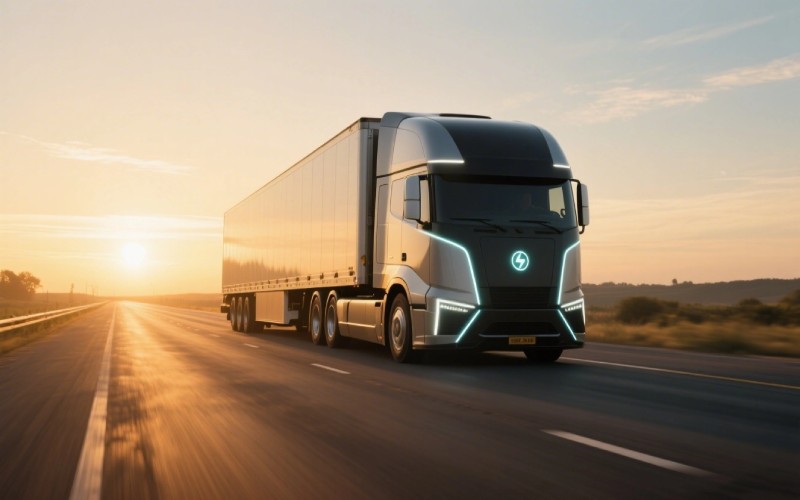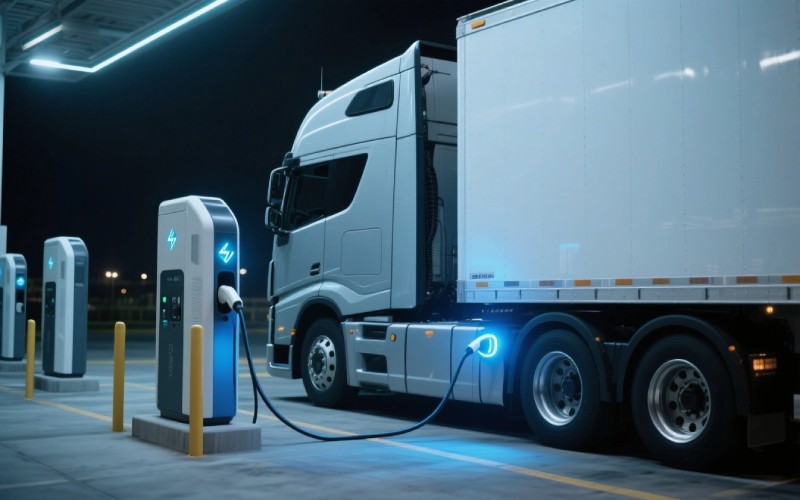Let Sino's Lamination Stacks Empower Your Project!
To speed up your project, you can label Lamination Stacks with details such as tolerance, material, surface finish, whether or not oxidized insulation is required, quantity, and more.

Electric semi trucks are here, and they are changing everything. You see them on the news and hear big companies talking about their new electric fleet. But what does it all mean? Are these new trucks the answer to all our problems, or do they come with their own set of challenges? This article is for you if you want to understand the real story behind electric trucks. We will look at the good parts and the bad parts, the pros and cons. You will learn about the cost, the range, the battery, and the infrastructure needed to support these amazing new vehicles.
I think the biggest reason for all the excitement is the environmental benefit. Traditional diesel trucks release a lot of pollution into the air. This emission is bad for our planet and our health. Electric trucks offer a simple solution. Because they run on a battery, they have zero tailpipe emission. This is a significant step forward. By using electric trucks, a company can greatly reduce its carbon footprint. This helps us all work toward a greener future and can reduce greenhouse gas problems.
But the benefits of electric trucks go beyond just clean air. Think about the driver experience. Electric vehicles are very quiet. This makes for a much more pleasant and less stressful ride. They also have instant torque, which means they can get moving quickly and smoothly, even in heavy traffic. Another big plus is maintenance. An electric truck has fewer moving parts than a traditional diesel truck. There is no internal combustion engine, no oil changes, and fewer things that can break. This means less time in the shop and more time on the road.
A company needs to make money to stay in business. The good news is that electric trucks can lead to big savings over time. The first area of savings is fuel. The cost of electricity is usually much lower and more stable than the price of diesel fuel. Over thousands of miles, the difference in fuel cost adds up. A large fleet could save a lot of money each year just by switching from diesel to electricity. These savings can make a big impact on a company’s bottom line.
The second area of savings comes from maintenance. As I mentioned, electric trucks have a simpler system. They don’t need the same frequency of service that diesel trucks do. Fewer parts mean fewer repairs and a lower maintenance cost. This is a significant benefit for any company that needs to operate a fleet of vehicles. While the initial price of the truck might be high, the long-term savings on fuel and maintenance can make the total cost to own and operate the vehicle much cheaper than a traditional truck.
The heart of any electric vehicle is its battery. The battery technology in electric trucks is amazing. It stores a huge amount of energy to power the vehicle for hundreds of miles. This battery is what makes zero-emission travel possible. A truck can perform its job without burning any gas or diesel. This is the main reason why we are even having this talk about electric semi trucks. The battery is the key to a cleaner transportation future.
However, the battery also presents several significant challenges. The pros and cons are clear. A bigger battery gives the truck more range, but it also adds a lot of weight and cost. The larger the battery, the heavier the truck becomes. This weight is a major concern for the trucking industry. Also, these large batteries take a long time to charge. The battery is both the greatest strength and the biggest challenge of the modern electric truck. We need battery technology to keep getting better to solve these issues.

One of the first questions everyone asks is about range. How far can an electric truck go before it needs to stop and charge? The answer is that it depends. Most new electric semi models can travel somewhere between 300 and 500 miles on a full charge. For some routes, this is plenty. But for long-distance trucking that goes across the country, this limited range is a huge challenge. A diesel truck can go over 1,000 miles on a single tank of fuel.
The range of an electric truck is affected by many things. The weight of the cargo has a big impact. A truck with a heavy load will use more energy and have a shorter range. The weather can also reduce the range, as cold temperatures can affect battery efficiency. This makes planning routes a very important task. A company must know the truck’s capability and plan stops to recharge the battery. This limited range is a significant barrier, especially for long-haul operations.
After range, the next biggest concern is charging time. When a diesel truck needs to refuel, the driver can pull into a truck stop and be back on the road in about 15 minutes. This is not the case for an electric truck. The time it takes to charge an electric semi is much longer. Even with the fastest chargers available today, it can take 30 to 90 minutes to get a significant charge. To fully charge a massive truck battery can take several hours.
These longer charging times create a logistical challenge. A driver might have to take a very long break just to recharge the vehicle. This downtime can reduce the efficiency of the entire transportation system. One solution is to charge the truck overnight at a depot. This works well for trucks that return to the same place each night. But for long-haul trucks that travel far from their home base, finding a fast enough charger and having the time to use it remains a big problem. The time to charge is a key hurdle to overcome for widespread adoption.
Yes, the weight of the battery is a very big problem. The electric truck batteries needed to power a heavy vehicle are huge and very heavy. An electric semi can be several thousand pounds heavier than its diesel counterpart. This extra weight is a significant challenge for the trucking industry because there are strict weight limits for vehicles on the road. The total weight of the truck and its cargo cannot go over a certain limit.
This extra truck weight has a direct impact on business. Because the vehicle itself is heavier, it can carry less cargo. Less cargo capacity means the company earns less money for each trip. This can make an electric truck less profitable than a diesel truck, even with fuel savings. The industry needs to find a balance. The manufacturer of each electric truck works hard to reduce the weight of the vehicle. But for now, the heavy battery remains a major concern that affects the amount of cargo a truck can legally carry.
When you go to buy a vehicle, the first thing you look at is the price. Right now, the upfront cost of an electric semi truck is much higher than a traditional diesel truck. The production costs are high, mostly because of the expensive battery. This high upfront cost is a big barrier for many companies, especially smaller ones. It is hard for a company to spend so much more money on a new and unproven type of truck.
However, we need to look at the total cost over the vehicle’s life. While the initial purchase price is a challenge, the lower operating costs can help. The savings on fuel and maintenance can eventually make up for the high upfront cost. Also, there are often government incentives to help reduce the price. These programs can make the electric truck more affordable. But until the initial production costs come down, the high price will remain a significant concern for many buyers looking to replace their old truck.

Imagine if every truck on the road today was an electric truck. Where would they all charge? The simple answer is that our current charging infrastructure is not ready. We do not have a widespread network of powerful chargers needed to support a large fleet of electric semi trucks. This is maybe the biggest challenge of all. A truck is useless if it cannot get the energy it needs to operate.
Building out the necessary charging infrastructure will be a massive and expensive job. We need special, high-power chargers at truck stops, distribution centers, and along major highways. This will require a huge investment from both private companies and the government. Without a reliable and convenient charging network, the dream of an all-electric transportation system cannot become a reality. This infrastructure must be built before we see the widespread adoption of these new electric vehicles.
This is a very smart question. An electric vehicle is only as clean as the electricity used to charge it. If the electricity comes from burning coal or natural gas, then we are still creating an emission, just somewhere else. This is a valid concern. The total environmental impact of an electric truck must include where its energy comes from. The goal is to reduce greenhouse gases overall, not just move them from the truck’s tailpipe to a power plant.
The good news is that our energy grid is getting cleaner. We are using more and more renewable energy sources like wind and solar power. As we build more clean energy, the environmental benefit of electric trucks becomes even greater. Even when the electricity comes from a mix of sources, it is often more efficient to manage the emission at a single power plant than from thousands of individual trucks on the road. For a truly greener future, we must focus on both building electric vehicles and creating clean electricity.
For a company to replace its trusted diesel trucks with electric trucks, a few things need to happen. First, the technology must continue to improve. We need better battery technology that provides longer range, weighs less, and can charge faster. The manufacturer of each electric truck is working hard on this. Second, the upfront cost needs to become more competitive with diesel trucks. This will happen as production increases and technology gets cheaper.
Finally, and most importantly, we must build a robust charging infrastructure. A driver needs to be confident that they can find a charger when they need one, no matter where they travel. This will require a coordinated effort. Government incentives can help speed up the adoption by making the trucks more affordable and helping to fund the charging network. When the technology is ready, the price is right, and the infrastructure is in place, we will see a major shift away from the traditional diesel truck and toward a cleaner, quieter, and more efficient electric future.